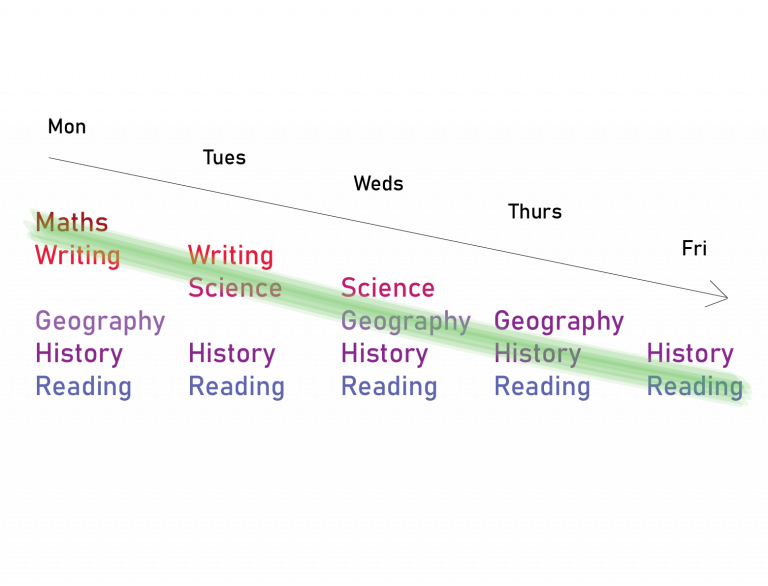
Taper scheduling is
- for students with a lingering problem subject
- for families who feel like we’re stuck in a rut
- for homeschool parents who have snapped at a child recently, after explaining the same thing for the umpteenth time
If you’re worried, like I was, that your child is absorbing your frustration with a subject, this method may be for you. Taper-scheduling takes the pressure off a subject without taking lengthy breaks from it.
What is Taper Scheduling?

Taper scheduling places the most difficult learning activities first, and tapers down throughout the day to the most enjoyable and passive activities. It tapers in the same way from difficult to enjoyable throughout the week.
It also tapers down the quantity of work. Because math is my daughter’s weakest subject, that is the subject we focus on at the start of the week. At the end of the week, only the beloved Read-Alouds are left.
The progression in taper scheduling is from activities that require active participation, like memorization, repetition and writing, to activities that require expression of learned ideas, discussion, or simply listening.
The colors of the words in the diagram above indicate levels of difficulty from red, being the most difficult for my eldest child at the moment, to blue, being the easiest. The arrow indicates the decrease in volume of work throughout the week. The green line highlights the emphasis of that day’s work.
Notice that the green line highlights two subjects each day. I might, for example, ask my daughter to write out what she notices about dividing the Math-U-See manipulative blocks. By connecting Math and writing, I help her process both from a different angle, and help plant it in long term memory. Marking out the locations of the history of science books you read on the Markable Map is one way of connecting the emphasized subjects on Wednesday.
Auditing in the Morning Meeting
It is the child’s active work that tapers down on this model. Crucially, the morning meeting stays consistent. We meet at the table every morning, we discuss our week, and I explain two key concepts for that week. I explain the main concept from Monday’s hardest lesson and one other concept.
This week I explained during the meeting about, dividing the clock-face and about the fall of Rome. I spent only a few minutes on each, explaining them in the clearest terms possible. I didn’t ask any questions;, I just asked them to audit the lesson. They simply listened in while doodling on paper.
How Does Tapering Increase a Child’s Confidence?
Actively studying math only once per week does relieve the pressure for my daughter. She is spared the indignity of failing a series of little verbal tests that usually result in focused tutoring. She maintains her dignity to make progress on her own terms.
But if we left math there, at one weekly lesson, she would not retain enough information each week to achieve the reward of progress. It would be discouragingly slow.
That is why auditing during the morning meeting is important. It protects retention without condescension. This week I played with sixty manipulative blocks and used technical phrases like divide to express my discoveries. When she audits my two-minute lecture, I’m not testing her; I’m displaying what I’m excited about discovering. That amounts to an invitation to conduct the same experiment for herself. Monday will give her the chance to do so.
An Example Week of Taper-scheduling
Monday
10:00 am: Morning Meeting
- Encouragements
- French
- Bible readings and memory verse
- Math idea: division
- History idea: the protestant Reformation
11:00 am: Three pages of the Math-U-See workbook with discussion
11:40 am: Write out a sentence about division
12:00 pm: Explain to parent last week’s math idea over lunch
13:00 pm: Copywork and Handwriting Without Tears
14:00 pm: Break
14:30 pm: Two pages of I Can Read It! Book 3
14:45 pm: History and Literature readings
16:00 pm: Finish
Tuesday
- 10:00 am: Morning Meeting (repeat from Monday, including the math idea)
- 11:00 am: Contractions activity from the Instructor’s Guide
- 11:30 am: Conduct an experiment from Usborne Book of Science Activities
- 12:15 pm: Lunch
- 13:15 pm: Write discoveries from the experiment
- 13:15 pm: Read two pages from the First Encyclopedia of the Human Body
- 13:45 pm: History readings with Mapping and Timeline activities
- 14:30 pm: Literature Readings with Timeline
- 15:15 pm: Finish
Wednesday
- 10:00 am: Morning Meeting
- 11:00 am: The Instructor’s Guide “Do it Together” Science activity
- 11:30 am: explain to parent your notes from yesterday’s experiment
- 11:45 am: two pages of the First Encyclopedia of the Human Body
- 12:15 pm: Lunch
- 13:15 pm: Geography readings with Markable Map
- 13:45 pm: Two pages of I Can Read It! Book 3
- 14:00 pm: History and Literature readings
- 15:00 pm: Finish
Thursday
- 10:00 am: Morning Meeting
- 11:00 am: Two pages of I Can Read It! Book 3
- 11:30 am: Geography readings
- 11:30 am: History Readings
- 12:00 pm: Lunch
- 13:00 pm: Literature readings
- 14:00 pm: Finish
Friday
- 10:00 am: Morning Meeting
- 11:00 am: History Reading
- 11:30 am: Literature reading
- 12:00 pm: Finish
Notice that Friday is nearly a day off. This light schedule is maintained, regardless of the work done on the previous days. Though tapering does communicate that the freedom of Fridays grows out of the soil of Monday’s discipline, it should never be contingent on work done. Even if they fail to work hard on Monday, Friday ought to be reserved for play, just as the Sabbath must be kept holy regardless of the week’s failings.
Tapering in this form may not be suitable as we get closer to preparing for exams, but it may work as a period of resetting. It has certainly helped us get out of a rut with our problem-subject. Taper Scheduling has restored the flow between memorization and expression, work and rest.









Hello, Mr Stewart:
So, taper scheduling is or is not what you do in your home regularly (full-time)? You use it just for s period of time to reset?
Thank you.
Hello, Dawne
Thanks for the question. I use it roughly in my regular home-ed. E.g Math is still on Monday, Friday is still a break. Duties first, then passions. But it's something we return to more closely when we need a reset. We actually write the detailed schedule when the week seems somehow unbalanced.
Hope this helps!